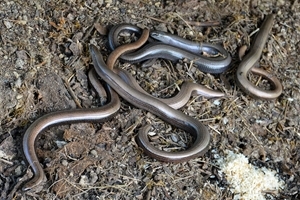Slow-worm
 The first thing to say about slow-worms is that they are neither a worm nor a snake, but a lizard without legs. They are also sometimes called “blind-worms” – and they are not blind either!
The first thing to say about slow-worms is that they are neither a worm nor a snake, but a lizard without legs. They are also sometimes called “blind-worms” – and they are not blind either!
A big slow-worm can measure up to a foot and a half, with males usually being a silvery grey or brown in colour, occasionally with a few blue spots on the back. The female, however, is usually golden brown on top, with dark brown sides and, quite often, a dark thin strip down the back as well.
A slow-worm, unlike a snake, has eyelids and can blink. Also, a slow-worm has no “neck”, again unlike a snake, which is much thinner between the head and the rest of the body, giving it that classic snake-like silhouette!
The slow-worm can be found across most of Britain, but is absent from Ireland. They use a range of habitats, requiring dense foliage to hide in and sunny spots to warm up in. Unlike snakes, they do not often lie out in sunshine, however, preferring to hide under matted grass, pieces of wood or stones, so that predators cannot see them. At dusk they will move out from their warm hide-hole to search for slugs, worms and insects to eat.
Mating takes place in late spring, with females then giving birth in late summer. The young slow-worms have been developing inside the female, so that the eggs hatch almost immediately they are laid, with on average around eight young being produced. The young slow-worms measure only around two and a half inches in length at this stage, yet they are independent straight away.
If they can avoid being eaten by a host of potential predators that would find them a tasty snack, slow-worms can live for a good length of time. In fact, one particular specimen in Copenhagen Zoo lived from 1962 until 2009!
In late October, slow-worms will move underground to hibernate, re-emerging once again the following March.
Slow-worms have evolved a great trick to avoid being caught and eaten. Firstly, they will try defecating a rather smelly substance in the hope that the predator will clear off. If this does not work and the attack continues, the slow-worm will then shed its tail. Now, here is the clever bit. The small tail-end will wriggle and twist around while the slow-worm itself will stay perfectly still. Often the attacker will be distracted by the moving tail piece, giving the slow-worm its chance to escape.
Although the slow-worm has survived the attack, losing its tail can be costly, as it now needs to use up resources to grow another tail. This can result in an individual, especially a youngster, not having enough sustenance to last it through the long winter hibernation period.
Slow-worms are protected under the Wildlife and Countryside Act 1981, so they should be left alone. Should you be lucky enough to have them living in your garden, remember that they are completely harmless and will spend most of the spring and summer munching up pesky slugs for you!
Peter Thompson
Advisory
Get the Latest News & Advice
Join over 100,000 subscribers and stay updated on our latest advice, research, news and offers.
*You may change your mind any time. For more information, see our Privacy Policy.